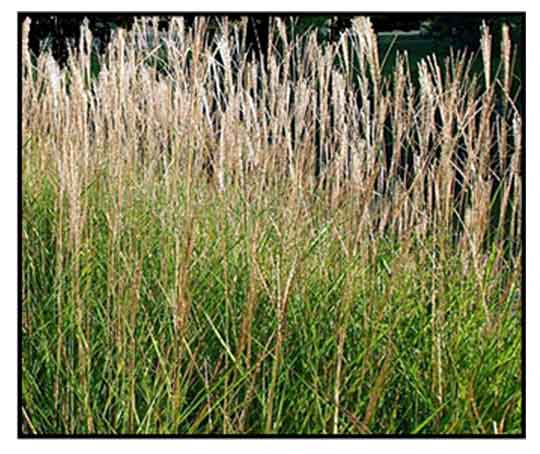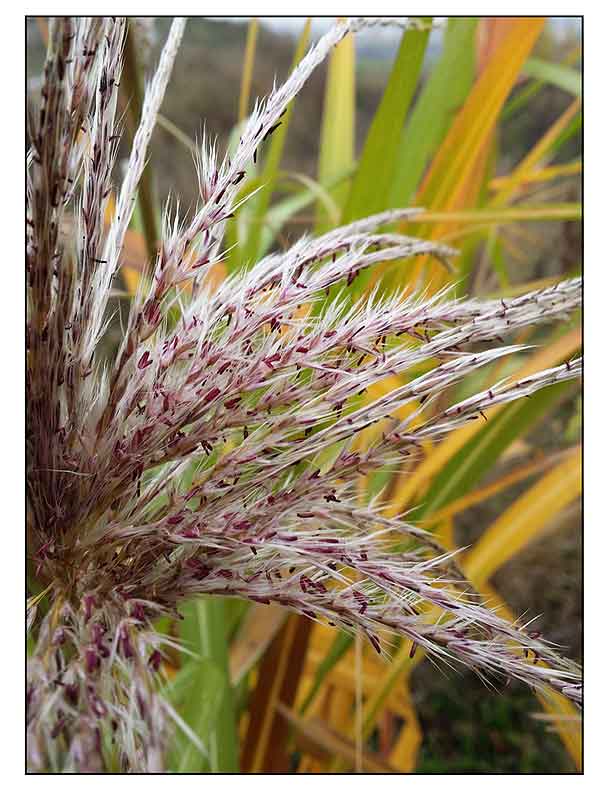
Family • Poaceae
Bigao
Micanthus sinensis Andersson
CHINESE SILVER GRASS
Mang
| Scientific names | Common names |
| Erianthus japonicus (Thunb.) P.Beauv. | Bigaho (Tag.) |
| Eulalia japonica (Thunb.) Trin. | Bigao (Bikol) |
| Eulalia japonica var. gracillima (Hitchc.) Grier | Bigau (Bikol) |
| Eulalia japonica var. zebrina (Van Geert) G.Nicholson | Bilau (Ifugao) |
| Eulalia japonica zebrina (Van Geert) Van Houtte | Rono (Ilokano) |
| Eulalia zebrina Van Geert | Chinese fairygrass (Engl.) |
| Miscanthus boninensis Nakai ex Honda | Chinese silver grass (Engl.) |
| Miscanthus chejuensis Y.N.Lee | Eulalia grass (Engl.) |
| Miscanthus chrysander Okubo | Japanese pampas grass (Engl.) |
| Miscanthus condensatus Hack. | Japanese silver grass (Engl.) |
| Miscanthus condensatus var. intermedius Y.N.Lee | Maiden grass (Engl.) |
| Miscanthus condensatus var. purpurascens Y.N.Lee | Pampas grass (Engl.) |
| Miscanthus condensatus f. purpurascens (Y.N.Lee) M.Kim | Plume grass (Engl.) |
| Miscanthus coreensis Hack. | Susuki grass (Engl.) |
| Miscanthus flavidus Honda | Zebra grass (Engl.) |
| Miscanthus hidakanus Honda | |
| Miscanthus ionandros Nakai | |
| Miscanthus kanehirawe Honda | |
| Miscanthus kokusanensis Nakai & Honda | |
| Miscanthus kokusanensis var. variegatus (Honda) Nakai & Honda | |
| Miscanthus kokusanensis f. variegatus Honda | |
| Miscanthus litoralis Honda | |
| Miscanthus matsudae Honda | |
| Miscanthus matsudae var. glabrescens Honda | |
| Miscanthus miser Nakai ex Honda | |
| Miscanthus nakaianus Honda | |
| Miscanthus neocoreanus Honda | |
| Miscanthus purpurascens Andersson | |
| Miscanthus pycnocephalus Honda | |
| Miscanthus pycnocephalus var. purpurascens Honda | |
| Miscanthus sinensis Andersson | |
| Miscanthus sinensis f. albiflorus (Y.N.Lee) M.Kim | |
| Miscanthus sinensis var. albiflorus Y.N.Lee | |
| Miscanthus sinensis f. chejuensis (Y.N.Lee) M.Kim | |
| Miscanthus sinensis var. chejuensis (Y.N.Lee) Y.N.Lee | |
| Miscanthus sinensis subsp. condensatus (Hack.) T.Koyama | |
| Miscanthus sinensis var. condensatus (Hack.) Makino | |
| Miscanthus sinensis var. coriaceus T.Mori | |
| Miscanthus sinensis f. crassiracemus Ohwi | |
| Miscanthus sinensis f. decompositus Nakai | |
| Miscanthus sinensis var. decompositus (Nakai) Honda | |
| Miscanthus sinensis var. formosatus Hack. | |
| Miscanthus sinensis f. glaber Nakai | |
| Miscanthus sinensis f. gracillimus (Hitchc.) Ohwi | |
| Miscanthus sinensis var. gracillimus Hitchc. | |
| Miscanthus sinensis f. hashimotoi Ohwi | |
| Miscanthus sinensis var. intermedius Matsum. | |
| Miscanthus sinensis var. ionandros (Nakai) Y.N.Lee | |
| Miscanthus sinensis var. keumunensis Y.N.Lee | |
| Miscanthus sinensis var. longiaxis Y.N.Lee | |
| Miscanthus sinensis var. nakaianus (Honda) I.C.Chung | |
| Miscanthus sinensis f. porphyrocomus Ohwi | |
| Miscanthus sinensis subsp. purpurascens (Andersson) Tzvelev | |
| Miscanthus sinensis f. purpurascens (Andersson) Nakai | |
| Miscanthus sinensis var. purpurascens (Andersson) Matsum. | |
| Miscanthus sinensis f. pycnocephalus (Honda) Ohwi | |
| Miscanthus sinensis f. transiticus Nakai | |
| Miscanthus sinensis var. transiticus (Nakai) T.Mori | |
| Miscanthus sinensis var. variegatus Beal | |
| Miscanthus sinensis f. variegatus (Beal) Nakai | |
| Miscanthus sinensis f. viridis (Y.N.Lee) M.Kim | |
| Miscanthus sinensis var. viridis Y.N.Lee | |
| Miscanthus sinensis var. yogoi Honda ex Yogo | |
| Miscanthus sinensis f. zebrinus (Van Geert) Nakai | |
| Miscanthus sinensis var. zebrinus (Van Geert) Matsum. | |
| Miscanthus transmorrisonensis Hayata | |
| Miscanthus zebrinus (Van Geert) Nakai ex Matsum. | |
| Ripidium japonicum Thunb, | |
| Saccharum japonicum Thunb. | |
| Saccharum roseum Reinw. ex Miq. | |
| Xiphagrostis condensatus (Hack.) W.Wight | |
| Xiphagrostis japonicus (Thunb.) Coville | |
| Miscanthus sinensis Andersson is an accepted species. KEW: Plants of the World Online |
|
| Other vernacular names |
| CHINA: Mang. |
| DENMARK: Kinesisk elefantgraes. |
| FRANCE: Miscanthus de Chine. |
| GERMANY: Schilfgras, Chinaschilf, Chinesisches stielbluetengras, Gemeines Chinaschilf. |
| INDONESIA: Walana 'in cuntung (Minahasa). |
| JAPAN: Obana. |
| NETHERLANDS: Prachtriet. |
| VIETNAM: Che ve trung hoa. |
Updated Oct 2023
March 2023
![]()
 |
| Â Â Â Â Â Â Â Â Â Â Â Â Â Â Â Â Â Â Â Â Â Â Â Â Â PHOTOS / ILLUSTRATIONS |
| IMAGE SOURCE: Photograph: Miscanthus sinensis - Chinese silvergrass / © Leslie J Mehrhoff / CC BY 3.0 US / click on image to go to source page / CABI Compendium |
OTHER IMAGE SOURCE: Photograph: Miscanthus sinensis / Stefan.lefnaer / Creative Commons Attribution Share Alike 4.0 International / click on image to go to source page / Wikimedia Commons |
Additional
Sources and Suggested Readings |
• |
DOI: It is not uncommon for links on studies/sources to change. Copying and pasting the information on the search window or using the DOI (if available) will often redirect to the new link page. (Citing and Using a (DOI) Digital Object Identifier) |
| Â Â Â Â Â Â Â Â Â Â Â Â Â Â Â Â Â Â Â Â Â Â Â Â Â Â Â Â Â Â List of Understudied Philippine Medicinal Plants |
| Â Â Â Â Â Â Â Â Â Â Â Â Â Â Â Â Â Â Â Â Â New plant names needed The compilation now numbers over 1,300 medicinal plants. While I believe there are hundreds more that can be added to the collection, they are becoming more difficult to find. If you know of a medicinal plant, native or introduced, to suggest for inclusion, please email the info: local plant name (if known), any known folkloric medicinal use, scientific name (most helpful), and, if possible, a photo. Your help will be greatly appreciated. |
• |
 |

 Gen info
Gen info
